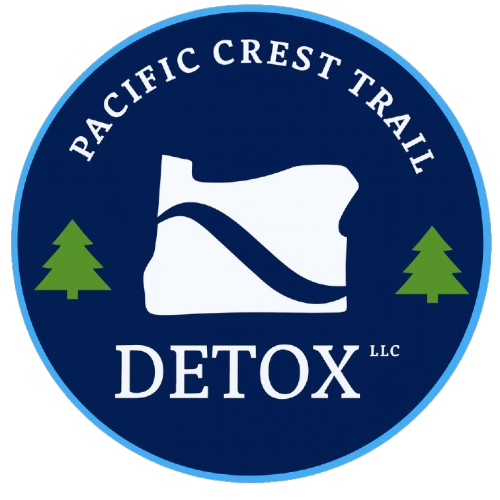Located in Milwaukie, Oregon, our ASAM III.7 certified facility offers 24/7 care from Registered Nurses and daily provider visits to ensure clients receive the highest quality care during the Dilaudid detox process.
We believe that recovery begins with proper detoxification, setting the foundation for long-term sobriety and healing.
Recognizing a Dilaudid addiction is the first step toward seeking help. The physical and psychological grip of Dilaudid can be powerful. As tolerance builds, people may find themselves taking larger doses, which increases the risk of overdose. This fact emphasizes the need for education on signs of addiction.
Common indicators include:
Continuing Dilaudid use without seeking professional help can lead to severe consequences.
The risks of untreated hydromorphone addiction include:
Dilaudid detox is the crucial first step in overcoming hydromorphone addiction. At Pacific Crest Trail Detox, we begin with a comprehensive medical assessment to understand each client’s unique needs and develop an individualized detoxification plan.
This assessment includes evaluating:
Based on this assessment, our medical team creates a personalized Dilaudid detox protocol designed to minimize withdrawal symptoms while ensuring safety throughout the process.
Withdrawal from Dilaudid typically begins within hours after the last dose and can include a range of uncomfortable and potentially severe symptoms.
The Dilaudid detox timeline generally follows this pattern:
The first hours include approximately 6-12 hours after the last dose. These symptoms are typically mild; however, they should not be ignored.
The initial 1-2 days of Dilaudid detox often mark the onset of withdrawal symptoms, requiring close medical supervision to manage discomfort and ensure patient safety.
These symptoms can include:
By days 3-4 of Dilaudid detox, withdrawal symptoms typically peak, demanding vigilant monitoring and targeted interventions to mitigate discomfort and prevent potential complications.
These more intense symptoms can be:
As the body begins to stabilize during days 5-7, withdrawal symptoms typically begin to subside, allowing for increased focus on comfort and the initiation of early recovery planning:
Following a week of detox, individuals often experience a significant reduction in acute withdrawal symptoms, marking a crucial transition towards building a foundation for sustained recovery and engaging in comprehensive treatment.
However, some symptoms may remain or appear:
The intensity and duration of these symptoms vary based on factors such as the length of Dilaudid use, typical dosage, individual physiology, and whether the client has undergone previous withdrawals.
Without proper medical supervision, these symptoms can be not only extremely uncomfortable but potentially dangerous, highlighting the importance of professional Dilaudid detox.
Here’s what you can expect with medically supervised detox:
At Pacific Crest Trail Detox, our facility is staffed around the clock with Registered Nurses who continuously monitor vital signs, withdrawal symptoms, and overall client well-being.
This constant medical presence ensures that any complications during Dilaudid detox are immediately addressed, preventing potentially serious health issues.
Our medical providers round on patients seven days a week, adjusting treatment plans as needed based on each client’s progress and comfort level. This level of care is crucial during Dilaudid detox, as withdrawal symptoms can fluctuate rapidly and require prompt medical intervention.
One of the most significant advantages of professional Dilaudid detox is access to medications that can alleviate withdrawal symptoms and reduce cravings.
This approach significantly reduces discomfort during the Dilaudid detox process, making it more manageable and increasing the likelihood of completing detoxification successfully.
Dilaudid detox affects not only the body but also the mind. The psychological aspects of withdrawal, including intense cravings, anxiety, and mood disturbances, can be as challenging as the physical symptoms.
At PCTD, we conduct 1-2 therapeutic groups daily, even during detox, to help clients begin addressing the psychological components of addiction immediately.
This early engagement in the recovery process helps clients develop coping strategies for managing cravings and emotional distress, setting the stage for continued treatment after the Dilaudid detox phase is complete.
The environment in which Dilaudid detox takes place can significantly impact the experience. Pacific Crest Trail Detox provides a comfortable, home-like setting that promotes relaxation and healing.
Our Milwaukie, Oregon facility offers:
At Pacific Crest Trail Detox, we’ve developed a comprehensive approach to Dilaudid detox that addresses the unique challenges of opioid withdrawal while providing compassionate, individualized care.
As an ASAM III.7 certified facility, PCTD meets the highest standards for providing medically monitored intensive inpatient services. This certification reflects our commitment to excellence in Dilaudid detox and other substance withdrawal management.
Our medical team includes:
This setting helps reduce the anxiety often associated with seeking treatment while still providing all necessary medical care.
Our technicians not only maintain this comfortable environment but also prepare nutritious, home-cooked meals three times daily. Proper nutrition plays a vital role in the recovery process, helping to restore physical health compromised by addiction.
Unlike many detox facilities that focus solely on physical stabilization, PCTD begins the recovery process immediately. We conduct 1-2 therapeutic groups daily, even during the acute phase of Dilaudid detox.
Early engagement in the recovery process significantly increases the likelihood that clients will transition to further treatment after completing Dilaudid detox, which is crucial for long-term success.
One of PCTD’s unique strengths is that our owners are in long-term recovery themselves and work as addiction counselors. This personal experience with addiction and recovery informs every aspect of our approach to Dilaudid detox.
Our owners understand firsthand the challenges of withdrawal and early recovery, allowing them to create a program that truly addresses clients’ needs with compassion and insight.
This lived experience translates into an unwavering commitment to provide the best treatment possible. Our “love with an edge” approach balances compassion with the firm boundaries necessary for effective recovery.
While Dilaudid detox is a crucial first step, it’s important to understand that detoxification alone is rarely sufficient for long-term recovery.
Continued treatment options may include:
The appropriate level of care depends on various factors, including the severity and duration of addiction, co-occurring mental health conditions, available support systems, and individual preferences.
Effective long-term recovery requires addressing the underlying factors that contributed to the development of addiction.
At PCTD, we help clients connect with treatment programs that offer these therapeutic approaches, ensuring continuity of care after completing Dilaudid detox.
Pacific Crest Trail Detox is committed to helping clients make smooth transitions to the next phase of their recovery journey. Our team works closely with various treatment providers to ensure that clients have appropriate aftercare plans in place before completing their Dilaudid detox program.
This seamless transition is vital for maintaining the momentum gained during detox and preventing the gaps in treatment that often lead to relapse. By connecting clients with quality continuing care options, we help build a foundation for lasting recovery from Dilaudid addiction.
Dilaudid addiction is a serious condition that requires professional intervention for safe and effective recovery. The Dilaudid detox process, while challenging, is a crucial first step toward reclaiming your life from hydromorphone dependence.
At Pacific Crest Trail Detox, we provide the medical expertise, compassionate support, and comfortable environment necessary to navigate this critical phase of recovery successfully.






